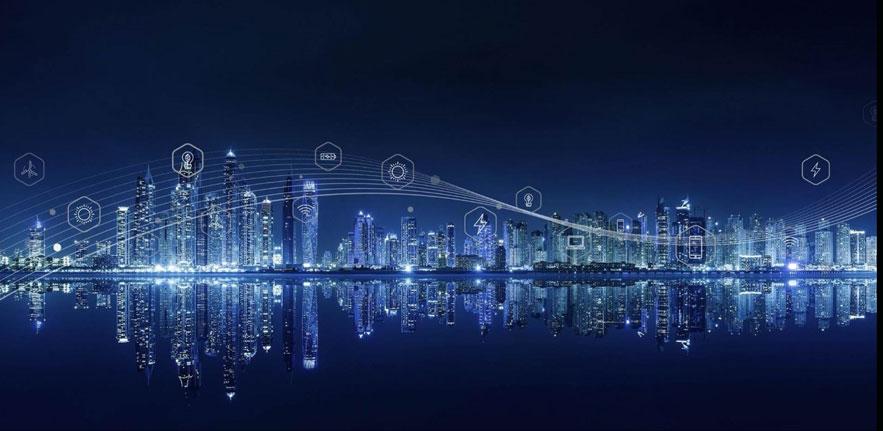
1 August 2022 - Building operations accounted for 27% of global carbon emissions in 2021, and with the number of buildings expected to double by 2060 it is increasingly important that building emissions are reduced. In this guest blog, Luiz Alevar, Senior Director at Envision Digital, explores the potential of AI and smart technology of meeting climate targets in the built environment sector.
Smart technology reduces 7–15% of building operating emissions by increasing energy efficiency using AIoT and Digital Twin modelling. Some of the world’s most iconic and classic buildings have reaped amazing results through embracing smart technology. The Empire State Building’s green retrofitting works cost over USD31 million and achieved energy savings of over USD4 million per year or a 38% energy reduction.
Retro-fitting smart technology to older buildings can be costly, but there has never been a better time to consider it. The last decade has seen significant shifts in the tech landscape, with the dramatic acceleration of smart technology installations within buildings as we strive for more efficient and sustainable operations. The complementary role of technology in reducing carbon emissions associated with buildings can accelerate a transition to a net zero future.
Digital Twin Modelling: A critical pathway for optimization and performance in buildings
A digital twin is a virtual replica of a physical building. Integrating technologies such as AI and IoT, digital twin acts as a bridge between physical and digital worlds with the use of sensors to gather real-time data to create a duplicate. This solution provides investment-grade business cases through simulations, bringing greater credibility to decision-making. Digital twin modelling allows facility managers to predict possible problems and eliminate risks of future output. As it is more efficient and economically viable to rectify defects in the virtual world, this solution can lead to continual design improvements and significant cost savings.
Building Digital Twin is a key pillar of emissions reduction to expedite net-zero transition
Digital Twins of buildings monitor the energy usage of the building, analyse areas that are underperforming and provide internal and external solutions to reduce emissions. Many technology companies, including Envision Digital, have developed advanced digital twin software to achieve this goal. There are three digital twin solutions that can help buildings cut energy consumption and emissions whilst identifying areas of improvement:
1. Energy, heat, water, and gas monitoring
The first step to improving energy efficiency is understanding the baseline consumption. IoT has enabled live monitoring across building equipment and assets in a single dashboard. This allows for easy tracking of equipment performance and energy consumption and triggering alarms when energy consumption exceeds certain levels. Such monitoring also enables automatic report generation, easing the burden on regulation compliance and improving productivity.
2. Smart Building Management System (BMS)
Greater benefits from higher energy efficiency can also be derived via the integration of an IoT-enabled BMS that enables intelligent decision-making, identifying savings and reducing energy consumption by 15-20%. Such solutions offer automatic fault detection on critical equipment such as HVAC, lifts, escalators, and lighting, reducing running costs and improving service levels. It also optimises asset performance that maximises asset lifespan. With a fleet control centre for real-time monitoring and analysis across assets, coordinated equipment management and centralised facility management, response speed to alerts and productivity increase by 20%.
3. Carbon Monitoring, Abatement and Offsetting
AI-assisted carbon management system is another key element of higher efficient buildings through the provision of accurate real-time emissions data. With effective planning and monitoring of abatement strategies, returns on investment can be maximised. Integration with onsite renewable generation and electric vehicle charging is also possible to generate revenue by selling excess renewable energy certificates (REC). Subsequently, once abatement efforts have been exhausted, net carbon emissions can be offset via smart integration with carbon credit and REC exchanges.
Looking Ahead
A prime example of a green retrofit project embracing the use of Digital Twin technology is the Entopia Building. Once a telephone exchange in the 1930s, it has transformed to become the headquarters for Cambridge Institute for Sustainability Leadership, the world’s first sustainable retrofit, and the first to achieve the EnerPHit, BREEAM Outstanding and WELL Gold standards for sustainability, health, and wellbeing.
The most sustainable building is one that already exists and avoids emissions of new builds, technology can help decarbonise all types of buildings, from the smartest to the oldest. More than enhancing energy efficiency and reducing environmental footprint, Envision Digital energy and carbon management solutions will have the potential to help Entopia increase visibility of operations, improve productivity, reduce operational costs, and ensure compliance with growing green building regulations. If technology can bring significant benefits to a remarkable building such as Entopia, it is expected to bring – even higher – benefits to most buildings.
Adopting smart building solutions can be the gateway to transforming cities all over the world, making extraordinary buildings an ordinary sight.
This blog was guest-written by Luiz Avelar Senior Strategy Director of Envision Digital. Envision Digital are a project partner of CISL’s Entopia Building – a world-first sustainable office retrofit setting new standards for low energy use, carbon emissions and impact on natural resources as well as user experience and wellbeing measured against multiple benchmarks. The approach taken to the Entopia Building’s sustainability performance includes a focus on reducing whole-life carbon impact (materials, construction, building use and end of life) and fabric-first energy efficiency. Working with Envision Digital, CISL hopes to leverage digital twin expertise to validate the building’s sustainable design assumptions.





